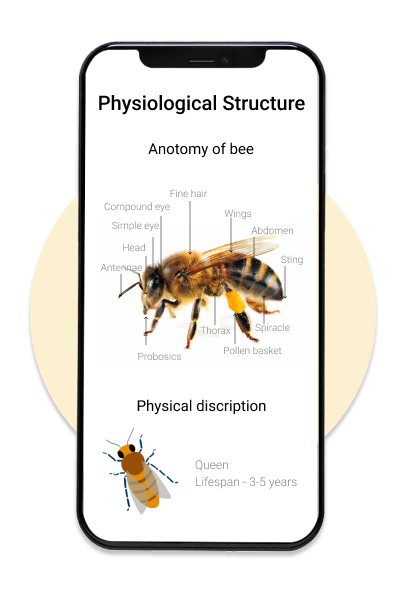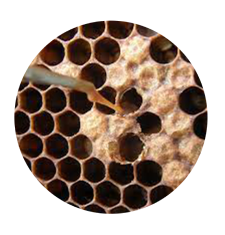Indica
An e-book guide to raising endangered honeybee species (Apies Cerena Indica)
Project Duration
Four months February - May 2022
Team
Hanoch Samuel
Research / Design -
Dr. Shivakumar
Apiculture Guide -
Bharath (research scholar)
Dr. Jagadesh
Language Guide -
Sunitha Kumari, Ajay G
Tools Used
Photoshop / Figma / Google doc/ Google translator
PROBLEM
Farmers are unsuccessful at raising Indian honey bees (Apis Cerana Indica)
The University of Agriculture and science, Bangalore, organizes 2 day workshops for farmers, beekeepers and hobbyists on raising indian honey bees. Yet most of them fail to raise them successfully. What is the reason?
THE SOLUTION
Accessible Information Guide (ebook)
* Increases the access to information for non-native speakers
* Helps the users with limited digital literacy to share and consume information easily
* Incorporation of many visuals, so the users understand the subject with the help of visual aid
A document which is shareable and in multiple languages
* Geographical distribution / Hive structure
* Physiological structure
* Social / Communication structure
* Honey Production process
Comprehensive information about the Indian honey bees.
* Hive setup / care
* Harvesting honey
* Diseases and Pests
* Economics of beekeeping
Specific knowledge on raising bees, challenges and economics of beekeeping
TO UNDERSTAND THE DOMAIN
Indian honey bees are endemic to the southern part of India.
Prof. Eshwarappa demonstrating how to harvest honey.
To understand the domain I attended the beekeeping workshop, Spoke to experts and professional beekeepers and started raising Indian Honey bees.
UNDERSTANDING USERS
Most farmers raise bees primarily for pollination and not for honey
Mr. Krishna gowda one of the trainee.
Analysis of the demographics of the trainees revealed 75% of the people who attended the workshop were farmers and the remaining 25% included hobbyists, entrepreneurs and students.
WHITE PAPER RESEARCH
People fail to notice the early warnings in the colony or the hive
By interviewing stakeholders and professional beekeepers. It was clear that people who begin to raise Indian Honey bees for the first time fail to notice the early warnings in the colony or the hive, and when they did notice the problem, they had no knowledge on why that problem occurred or how to solve it.
“Frequent checks on the hive and the colony is the best and the only defense against diseases and pests. If the problem is ignored even for a day or two it's highly likely you will lose the colony”.
- Dr. SN Bhat (profesor of Apiculture)
GAP
Access to information when necessary
There is no accessible information about raising Indian honey bees or trouble shooting when in crisis, except contacting the Apiculture department of University.
USER INTERVIEW
We don’t know why the bees swarmed
Empty hive
I interviewed 12 trainees who attended the workshop. In which four of them were attending the workshop for the second time as they had lost their colonies earlier for reasons they did not understand.
Interview questions
1 . Have you raised bees before? / Why do you want to raise bees?
2. What language do you sepak / read?
3. How was your experience attending the workshop / what are the likes and dislikes about it?
4. Do you use any phone applications? If so, what are they?
5. Do you have access to the Internet?
MAIN INSIGHTS
The trainees who attended the workshop spoke 6 different languages
Prof Jagdish teaching the trainees
Language / Geography
People spoke and read 6 different languages.
The workshop had a huge language barrier which made it hard for the trainees to understand.
The Interviewees came from 3 neighbouring states.
The geography of the interviewees had specific challenges to raise bees.
Technology / Internet
Everyone who attended the workshop had a smartphone.
Most users digital litracy was poor.
Whats app and facebook were the two most used apps by the Interviewees.
Many users had poor to no access to internet in their villages.
Workshop / Learning
The interviewees felt the duration of the workshop was less.
The trainees did not remember all the information from the workshop..
They liked the practical sessions of the workshop more than the theory classes.
The trainees were excited to raise bees after the workshop.
FARMER PERSONA
DESIGN
Possible solutions
Why an e-book?
Considering the access to the Internet, digital literacy of the user, the development of the product, accessibility in terms of language and ability to be shared easily on Whatsapp and facebook, I chose to go with the e-book as an ideal medium to achieve the goal. Also it could be made in multiple languages.
CONTENT DESIGN
What should I add ?
By speaking to the stake holders, professional beekeepers and the end users, there were two topics which were vital.
1. About Indian honey bees
2. Raising Indian honey bees
With these two topics as the foundation, I further added sub topics for each topic.
VISUAL DESIGN
Conveying the information accurately
Initially I planned to illustrate the visuals as it was practical and easy to understand., but looking at the content I realised real photographs and animation was vital to communicate the information accurately, so I used a combination of illustrations, photographs and animated gif for visuals.
Young bees
Adult bees
Juvenile bees
Illustration explaining the housing area of bees
Picture of European foulbrood infestation
Animation of Waggle dance
TESTING AND IMPLEMENTATION
Moment of truth
The testing started by sharing the pdf document with farmers, beekeepers, professors and based on the user and peer feedback I continually Iterated the design in which there were three major improvements.
Navigation
One of the things the peers suggested was to make the content clickable so the user lands on the desired page instead of scrolling all the way.
Hyperlink
While observing the users during user testing, I noticed they wanted to know the meaning of scientific terminology. To address the issue I made hyperlinks to these words which landed them in Wikipedia.
Additional information
From the user feedback, Firstly, the users wanted to know additional information, like bee products that could be monetized other than honey. Secondly, the users also wanted to know the economics of beekeeping. So I went on to add these two chapters.
The final product
The final product is a sharable document which can be shared in WhatsApp, Facebook and other social media website. The document is in 5 languages, It provides comprehensive information about bees and can be accessed without internet.
Learning
Although I could not make the book with 5 languages in a single sharable file. I was able to make pdf’s in 2 languages Kannada and English and share them. By end of the journey, it was clear I had a long way to go. However here are a few things I learned from the experience.
Research is imperative without any compromise.
This was the first time I was doing serious work in Figma so, I got to learn about designing and prototyping processes in depth.
By working with people from different professions, I learnt to approach things from multiple perspectives.
Realised the importance of a design system.
Got a chance to learn very interesting things about honeybees.
Future plan
In the future, firstly I want to make this into reality. Secondly going ahead I would like to make an app. Which can be used to find information, collect data and connect bee product producers and bee product consumers within the app.
Why an app?
An app can increase a lot of features for the users as well as stakeholders. Example - Features like having a forum where the users can interact and the update will help scientists collect data and take action immediately especially when a disease is detected. On top of it, an app can have information about other species of honey bees that are endangered and endemic to India and help in the conservation of the species.


























